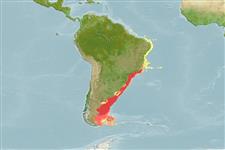Environment: milieu / climate zone / depth range / distribution range
Ecology
Marine; demersal; depth range 15 - 200 m (Ref. 47377). Subtropical
Southwest Atlantic: southern Brazil to Argentina (Ref. 47377).
Length at first maturity / Size / Weight / Age
Maturity: Lm 16.0 range ? - ? cm
Max length : 38.1 cm TL male/unsexed; (Ref. 55642)
Life cycle and mating behavior
Maturity | Reproduction | Spawning | Eggs | Fecundity | Larvae
Cervigón, F. and W. Fischer, 1979. INFOPESCA. Catálogo de especies marinas de interes economico actual o potencial para América Latina. Parte 1. Atlántico centro y suroccidental. FAO/UNDP, SIC/79/1. 372 p. FAO, Rome. (Ref. 6077)
IUCN Red List Status (Ref. 130435)
Threat to humans
Harmless
Human uses
Fisheries: commercial
Tools
Special reports
Download XML
Internet sources
Estimates based on models
Preferred temperature (Ref.
123201): 5.4 - 20.5, mean 8.9 °C (based on 272 cells).
Phylogenetic diversity index (Ref.
82804): PD
50 = 0.5000 [Uniqueness, from 0.5 = low to 2.0 = high].
Bayesian length-weight: a=0.01072 (0.00694 - 0.01654), b=2.95 (2.82 - 3.08), in cm total length, based on LWR estimates for this species & Genus-body shape (Ref.
93245).
Trophic level (Ref.
69278): 4.2 ±0.73 se; based on food items.
Generation time: 8.5 ( na - na) years. Estimated as median ln(3)/K based on 1
growth studies.
Resilience (Ref.
120179): Low, minimum population doubling time 4.5 - 14 years (Preliminary K or Fecundity.).
Fishing Vulnerability (Ref.
59153): High vulnerability (55 of 100).
Nutrients (Ref.
124155): Calcium = 76.3 [38.1, 178.2] mg/100g; Iron = 1.14 [0.60, 2.29] mg/100g; Protein = 17.1 [14.8, 20.0] %; Omega3 = 0.568 [0.259, 1.479] g/100g; Selenium = 28.8 [13.6, 80.7] μg/100g; VitaminA = 29.9 [9.6, 98.0] μg/100g; Zinc = 0.688 [0.466, 1.018] mg/100g (wet weight); based on
nutrient studies.
